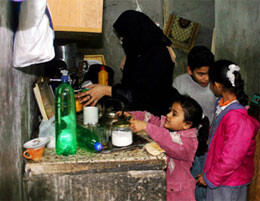The Electronic Intifada 7 December 2007

Naheda Ghabaien’s family, living in Beach refugee camp, are dependant on UNRWA food aid. (IRIN)
The cost of many basic items, such as beef, wheat and some dairy products have increased significantly, while locally grown produce is fetching extremely low prices on the local market, as exports are banned, threatening the livelihood of farmers.
Since the Hamas takeover of Gaza in June, the commercial crossing points with Israel have been all but shut, except for the import of basic humanitarian goods. Israel said it could not operate the crossings with Hamas, which it deems a terrorist organization, controlling the other side.
Israel is imposing the restrictions in retaliation for the continued firing of missiles from Gaza into Israel.
A spokesman for the Israeli prime minister’s office said there “cannot be business as usual” with the Gaza Strip as long as rocket attacks against southern Israel continue.
“Israel is committed to the continued supply of the essential humanitarian support to the people of Gaza,” said spokesman Mark Regev, who added that it was up to the ruling Hamas movement to stop the rockets.
Rise in requests for charity
Israeli travel and trade restrictions have led to a decline in purchasing power in Gaza. A recent WFP survey found that of the 62 percent of people who said they had reduced their expenditure in recent months, 97 percent reported a decrease in spending on clothing and 93 percent on food.
“The number of people in need is increasing and the percentage of people we can help is low,” said Nasser al-Sharqawi, from al-Falah, a local Islamic charity. Half of all non-refugees in Gaza receive WFP food aid, while UNRWA, the UN Palestinian refugee agency, helps over 80 percent of refugees. About 70 percent of Gaza’s population are refugees from the 1948 War.
Now, like tens of thousands of Gazans who have lost their jobs since June — when Hamas seized control and tight travel and trade restrictions were imposed on the territory — Yousef only works a few days a month.
Every three months, Naheda said, the family receives from UNRWA amounts of rice, flour, oil and sugar that can last for four to six weeks. The family rarely eats meat anymore, relying mostly on vegetables.
“When the agency food runs out, we buy the food we need on credit from the grocer. When my husband works, most of his daily earnings go to settling the debt,” she told IRIN.
Aid workers say these sorts of coping mechanisms are reaching their limits as the economy in Gaza continues its downward spiral.
Agriculture hit
The UN Food and Agriculture Organization (FAO) has said farmers have so far lost $4.5 million due to the squeeze on imports and exports since June 2007. However, the main season for exporting cash crops began in November, and the Palestinian Ministry of Agriculture has estimated that farmers will lose another $50 million this season, if they cannot export to Israel and other foreign markets.
According to the Palestinian Agricultural Relief Committees, about 25 percent of Gazans rely directly or indirectly on agriculture for their income.
Farmers who used to export can only earn a fraction of their profits on the local market, which is now over-saturated, according to FAO. For example, last year strawberries were sold at $6 per kilogram, while now the price has dropped to 40 cents on the local market. Potatoes dropped from about $2.5 per kilo on the export market to only about 12 cents locally, according to aid workers and residents.
“The potato business has been killed and the strawberry business is in the emergency room,” said farmers recently in the northern Gaza town of Beit Lahiya. The significant drop in profit means some are working at a loss and many question if they will be able to replant next year.
Israel recently allowed out several trucks of strawberries and carnations, but locals say this will hardly be enough. In addition, many goods, such as fertilizers and pesticides, are not making it into Gaza or in such small numbers that their cost is beyond the reach of most farmers.
“Unless all terminals are fully opened within the upcoming weeks, both for exports and imports, the agricultural sector in Gaza is facing a major catastrophe,” said Santiago Rippoll, a FAO food security analyst.
This item comes to you via IRIN, a UN humanitarian news and information service, but may not necessarily reflect the views of the United Nations or its agencies. All IRIN material may be reposted or reprinted free-of-charge; refer to the copyright page for conditions of use. IRIN is a project of the UN Office for the Coordination of Humanitarian Affairs.
Related Links

